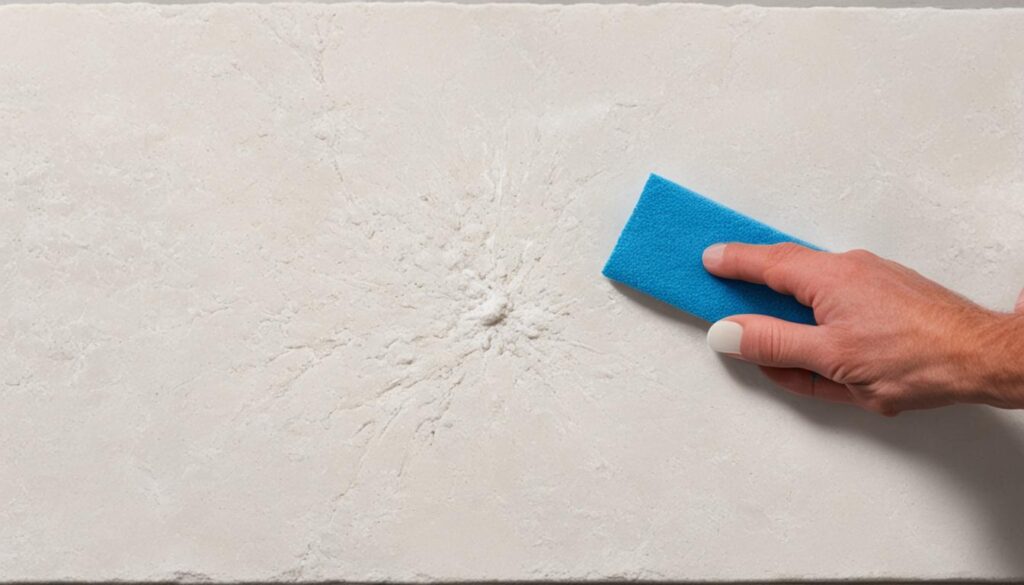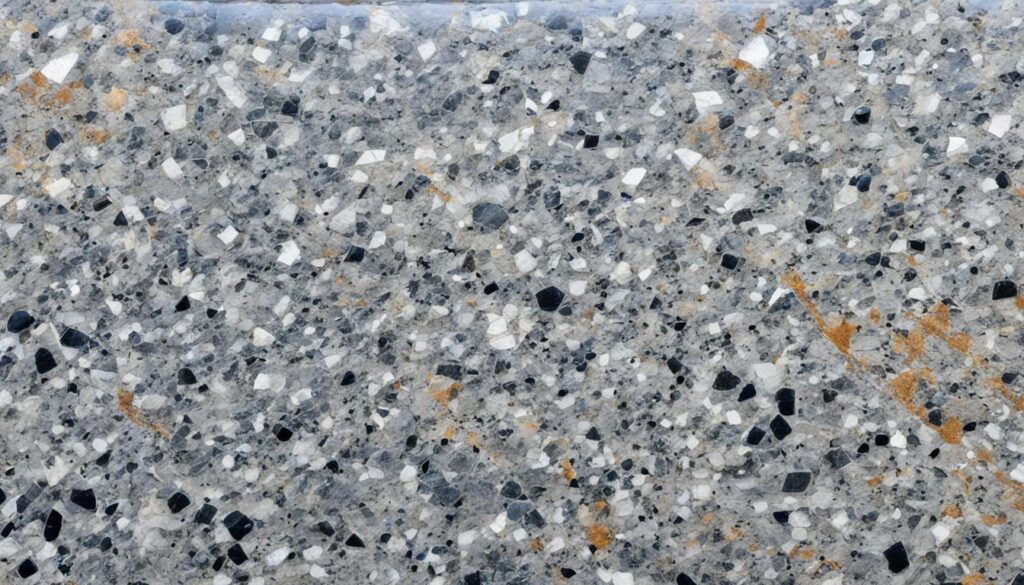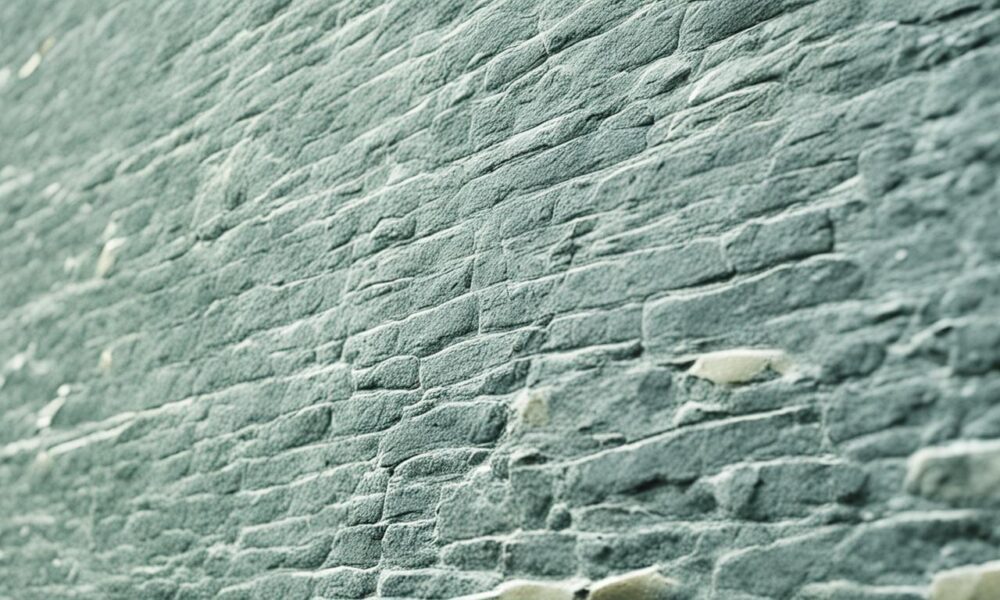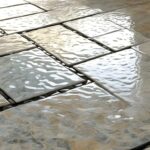Easy Natural Stone Scratch Repair Solutions
Natural stone surfaces add a touch of beauty to homes all over America. They come in many forms, like durable granite counters, beautiful marble floors, or limestone decorations. Even the toughest stones can get scratched or damaged over time. This leads homeowners to look for natural stone scratch repair solutions. They want to keep their stone’s beauty alive.
Fixing scratches on marble or granite might seem hard, but it doesn’t have to be. There are easy DIY fixes or you can call professional stone repair services for serious damage. The trick is to act quickly and take good care of your stone. By doing regular upkeep and getting expert stone restoration help when needed, you can keep your stone perfect. This helps your stone last longer and stay beautiful.
Key Takeaways
- Natural stone surfaces require diligent care to maintain their aesthetic appeal.
- Minor scratches on natural stones can often be remedied with simple at-home solutions.
- For deeper scratches, professional stone repair services provide comprehensive restoration.
- Implementing routine maintenance is crucial for extending the lifespan of stone surfaces.
- Understanding the specific care needs of different stone types like marble, limestone, and granite is essential for effective damage prevention and repair.
- Periodic expert inspections can ensure stone surfaces remain in optimal condition.
Understanding the Susceptibility of Natural Stones to Damage
Natural stones like limestone, marble, and granite are loved for their beauty and how long they last. But, they can still get damaged. Knowing about the specific ways these stones can get hurt helps homeowners take care of them better. This includes repairing scratches and other damages when they happen.
The Vulnerability of Limestone and Marble to Etching
Limestone is easily damaged by acids because it has a lot of calcite. Marble is similar because it’s related to limestone. So, things like lemon juice, wine, and some cleaners can harm marble and limestone surfaces. Homeowners need to be careful with what they use on these stones.
Why Granite is Prone to Scratches Despite Its Hardness
Granite is known for being tough, but it can still get scratched. Kitchen countertops made of granite can suffer if care is not taken. Sharp tools, abrasive cleaners, or heavy objects can scratch them. It’s important to fix scratches quickly and handle granite with care to keep it looking good.
| Stone Type | Risk Factor | Preventative Measures |
|---|---|---|
| Limestone | Highly sensitive to acids, prone to etching | Use neutral pH cleaners, immediate clean-up of acidic spills |
| Marble | Vulnerable to staining and etching | Regular sealing, avoidance of acidic products |
| Granite | Prone to scratches from sharp objects | Use cutting boards, refrain from abrasive cleaning practices |
To keep natural stone surfaces looking beautiful, we need to know their traits. Taking care of marble, being cautious with limestone, and respecting granite’s needs are key. If stones do get damaged, professionals can fix them, bringing back their beauty.
Maintaining Natural Stone Surfaces: Prevention Strategies and Care
Using scratch prevention strategies helps keep natural stone surfaces looking new. These methods protect the beauty and strength of the stone. This way, you might not need professional stone repair as often, saving money.
It’s also crucial to perform regular stone surface maintenance. This can stop the need for big repairs like granite scratch repair. With consistent care, natural stone stays in top shape, avoiding unexpected fixes.
To help homeowners, this guide outlines key natural stone care tips:
- Always use cutting boards in the kitchen to avoid scratches on stone countertops.
- Quickly clean spills to prevent stains and damage from acidic foods and drinks.
- Avoid using harsh cleaners that can harm stone surfaces.
- Occasionally get high-quality stone polishing to keep the stone’s shine.
Also, sealing stone surfaces regularly is crucial. The right time to reapply depends on how much the stone is used and the maker’s advice.
| Prevention Strategy | Benefits | Maintenance Frequency |
|---|---|---|
| Use of Stone Sealants | Protects against stains and light scratches | Every two years or as recommended |
| Regular Cleaning with pH-Neutral Solutions | Keeps finish looking new and avoids damage | From daily to weekly, depending on use |
| Applying Stone Polish | Makes stone shine and adds protective layer | Every 1-2 years or when needed |
For the best results, mix daily care with expert advice. While you can handle simple upkeep and small scratches, serious damage might need professional stone repair. Professionals have the right skills and tools for complex repairs. This ensures lasting and attractive results.
Choosing the right stone care products and getting help from pros for check-ups are key. Quick and proper care prevents minor problems from becoming big, expensive ones. This keeps natural stone looking great and in good condition.
Natural Stone Scratch Repair for Limestone Surfaces
Limestone is known for its natural beauty and is common in US homes. Sadly, it easily gets scratched, ruining its look. But, don’t worry. You can fix these flaws. Here, we talk about DIY natural stone repair and professional stone repair services. This will help keep your limestone looking good for years.

DIY Solutions for Light Scratches in Limestone
If you have light scratches on limestone, there are ways to fix it yourself. Start by gently sanding the scratch with very fine sandpaper. Another option is to apply mineral oil to make the scratch blend in. Here’s a step-by-step guide for those ready to try DIY repair:
- Find the scratch and clean the area well.
- Put mineral oil on a soft cloth and rub it on the scratch.
- For bigger scratches, sand lightly in circles with fine sandpaper.
- Buff with a clean cloth to bring back the stone’s shine.
This method works for small marks, but you might need a pro for bigger problems.
When to Call a Professional Stone Repair Expert
Big or noticeable scratches on limestone need a pro’s touch. This is especially true for polished or light-colored stone. Expert stone restoration pros have the right tools and know-how. They do things DIY can’t, like high-quality stone polishing and repair.
| DIY Repair Technique | Professional Repair Service |
|---|---|
| Mineral oil application | Diamond grinding and polishing |
| Gentle sanding with fine sandpaper | Application of custom color-matched fillers |
| Home buffing for a sheen | Protective sealant application |
If scratches have hurt your limestone’s beauty, talk to limestone scratch repair professionals. They don’t just fix the look. They make sure your stone stays strong and pretty for a long time. They use the best tools and materials, like diamond abrasives and special polishes, for perfect fixes.
Valuing your limestone means letting experts in stone restoration take care of it. This way, you ensure it stays elegant for future generations.
Granite Scratch Removal: Techniques for a Flawless Finish
Granite surfaces are known for being tough and beautiful. Still, they can get scratched. The first step is to figure out how bad the scratch is. You can use simple home methods or get help from a pro to keep your granite looking great.
Determining the Severity of Granite Scratches
Knowing how deep the scratch is on your granite countertop is key. Light scratches need easy fixes. But deeper ones might require pro tools and skills for the best fix.
Home Remedies for Minor Granite Scratch Repair
For small, fine scratches, there are easy fixes you can try at home. Use warm soapy water to gently buff out these marks. Or use special stone care products like resin sticks or fine steel wool. These methods will keep your granite shiny and new-looking.
If the scratch doesn’t go away with these first tries, it’s time to call a specialist. They use special tools like sealers or diamond polishers. This not only fixes the blemishes but also refreshes the granite’s protective layer. Keeping it looking fresh and new.

| Scratch Type | Home Remedies | Professional Solutions |
|---|---|---|
| Light Scratches | Warm water & soap, Baking soda paste, Resin sticks | Diamond polishing, Sealant application |
| Deep Scratches | Ultra-fine steel wool | Fillers, Grinding & refinishing |
| Surface Etching | DIY Polishing kits | Professional re-polishing |
Whether you’re using home remedies for stone repair or getting a pro’s help, the right care keeps granite perfect. With these tips, your granite will stay gorgeous and valuable for many years.
High-Quality Stone Polishing: Restoring Natural Stone Shine
To get a shiny, professional look on natural stone, specific tools and methods are needed. One key method is high-quality stone polishing. This process fixes dull and scratched stone, making it look beautiful.
The Role of Diamond Polishing Pads in Stone Restoration
Diamond polishing pads are vital for restoring stone. They smooth out surface flaws and make the stone shine beautifully. Using them makes the stone look scratch-free and evenly shiny.
Diamond polishing pads come in different grit sizes. The process starts with coarse pads and finishes with finer ones. This gradually polishes the stone to a shine.
Step-by-Step Process for Eliminating Deep Scratches
The restoration process carefully fixes flaws and polishes the stone. This makes natural stone look new and professionally finished.
- Inspection: Finding areas that need work and choosing the right diamond pad grit size.
- Preparation: Cleaning the stone and setting up the polisher and safety gear.
- Coarse Grinding: Starting with the coarsest grit to remove big scratches.
- Mid-stage Polishing: Switching to a medium grit for further smoothing.
- Finishing Touch: Using fine grit pads for a professional shine.
- Cleaning: Wiping the stone to check the finish.
Water is used throughout to cut down on dust and help the pads work better. This gives a finer, cleaner finish, showing the quality of the work.
| Grit Size | Scratch Size | Expected Outcome |
|---|---|---|
| Coarse (50-100) | Deep Scratches | Leveling Surface |
| Medium (200-400) | Medium Scratches | Surface Smoothing |
| Fine (800-1500) | Fine Scratches | Enhancing Luster |
| Ultra-Fine (3000+) | Microscopic Imperfections | High-Shine Professional Finish |
Following this detailed method brings stone back to life. It removes scratches and brings back the stone’s original shine. Thus, diamond polishing pads are crucial for getting a beautiful finish on natural stone.
The Importance of Regular Natural Stone Care and Maintenance
Taking care of natural stone is all about being thorough and consistent. Everyday use can wear surfaces down, but regular maintenance stops ugly scratches. To keep these surfaces looking luxurious and strong, a good care routine is key.
Having a pro fix your stone is a big part of keeping it nice. By fixing small damages early with scratch removal and stone restoration, you avoid big problems later. This not only saves money but keeps the stone’s look and value over time. Expert services offer a level of care that home methods can’t match.
Being dedicated to regular stone maintenance and quick fixes is crucial for homeowners who love their stone’s beauty. Watching closely for any damage and fixing it right away keeps the stone looking great. This way, natural stone can remain a beautiful and tough part of your home.



